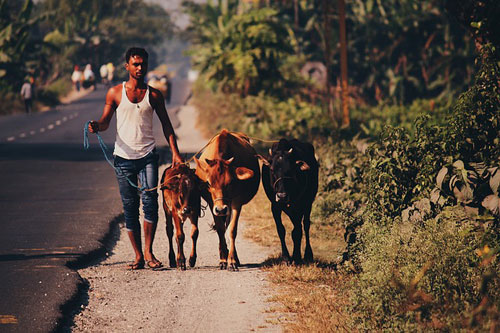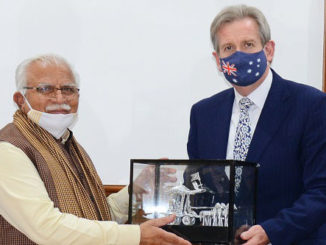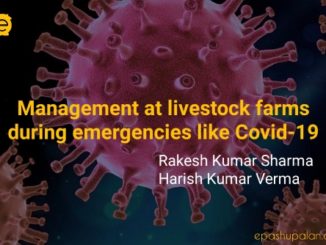Introduction
The milk production in India saw a quantum leap from 17 (Seventeen) million tonnes in 1950 to 187 (One hundred eighty seven) million tonnes in 2018-19. At global scale the meat production more than quadrupled since 1961. The global population suffering from hunger declined 31% since 2000. What all these data authenticates is that the Livestock production and productivity is closely intertwined with several United nations Sustainable development goals (SDG) from no poverty to Zero hunger to affordable and clean energy among others. Livestock production has been gateway to human food security and prosperity. In India livestock 70% (Seventy percent) of rural household owns livestock and it is believed to be important harbinger in achieving ambitious goal of doubling the farm income by 2022.
The Need for Livestock Production and Measures to Ensure it
Since prehistoric times livestock has been important source of proteins, nutrients in human diet. Besides meat, eggs and milk, livestock are important source of Hides, wools, hairs, draught, fuel, fertilizers and even medicines. Harnessing livestock for benefit of mankind has been major accomplishment of humanity. The livestock productions and productivity has been rapidly rising particularly in developing economies driven by increasing per capita income, urbanization, modernization, health and nutrient consciousness of the masses. Besides the carving for nutrient security, livestock productions and productivity has been largely driven by successful breeding experiments, advancement in genetic screening, biotechnology imbibing food fortifications, artificial intelligence, robotics, supportive government policies, improved chain of value additions from farms to fork etc. However livestock production and productivity consistently faces several constraints pertaining to land, expertise labor, input capital, disease outbreaks, environment activism, processing and marketing, ethical and socio-cultural dilemmas.

Jacques Diouf once the director of UN Food and Agriculture organization (FAO) once quoted, “Hunger is not an issue of charity, it is an issue of Justice”. It is deplorable to acknowledge that even in present scenario around 690 million people goes hungry and undernourished. The sustainable solution lies with livestock. There exists both cause and effect type direct correlation between livestock production, per-capita income and protein intake. Most of the animal proteins from meat or milk are complete proteins fulfilling amino acids requirements of the body and important for physical strength, body development, defense and cognitive capabilities of an individual. As per one of the studies in Kenyan school children the provision of animal based dairy or meat products resulted in reduced incidences of child stunting and child wasting. Similar is the story in other parts of the world including India. Undoubtedly when one do comparative analysis at global scale the incidence of underweight children (under 5 years of age) declined from around 25% in year 1990 to 15% in 2015. While in the same period the global meat production escalated from 180 million tonnes to about 340 million tonnes. Not just proteins, most of the dairy, poultry and meat products have much more abundance of Calcium, vitamin B12, iron and others which are important for proper growth, wisdom, strength and immunity of the body. This makes livestock production even more important for a country like India at its demographic dividend stage. Reaping the benefit of young population will require their nutrient security as the very first step.
Undoubtedly India realized the importance of livestock as catapult for nutrition security, rural employment etc., long ago and started with several steadfast initiatives to promote livestock production and productivity.
The National Dairy Development Board (NDDB) was established in 1965 which launched operation flood in 1970 (Fostered by Verghese Kurien) proved landmark in making white the color of prosperity for over 15 million farmer family with immense viability, profitability and achieving self-reliance in the sector. Focus also went on to livestock insurance, fodder development. In the year 2014-15 a comprehensive National Livestock Mission was launched with objective of quantitative and qualitative improvement in livestock production and capacity building of all stakeholders chiefly the small-holder livestock farmers. The other breakthrough initiatives includes The Gokul Mission which focuses on conserving indigenous breeds, National artificial insemination programmes, Animal husbandry start up grand challenges. All these contributed in making India a country sustaining 18 % of world cattle population with only in 2.4% of world land.
Government can act as facilitator and resource provider. The saga of enhanced livestock production and productivity is assured through deploying of innovations and technology throughout the whole supply chain of livestock industries from farm to forks. The conventional breeding experiments and application of biotechnology ranging from artificial insemination (AI), germplasm selections, embryo transfer, cryopreservation contributed in improving livestock breeds. The biotechnology also helped to improve animal nutrition e.g. recombinant microbes culture releases probiotics that improves digestion in animals. The biotechnology also helped in food fortification now we have many brands of milk fortified with vitamin A & D. From Vaccination to drug discovery biotechnology has wide application in improving animal health. These days the automation in animal farms are the new big thing in improving livestock production and productivity. The air conditioning system, monitoring drones, artificial incubators, milking robots now are at center stage of livestock production. The other marked innovations were seen in at the level of preservation, processing, transport and marketing.
The Challenges in Livestock Production and the way forward
Besides the best endeavours made to improve the livestock production and productivity there are some challenges that consistently haunts the sector. The biggest as claimed by researchers is the animal health. Several infectious contagious diseases like that of Foot and Mouth (FMD), Brucellosis, lumpy skin diseases, Pica, black quarter infections, repeated outbreaks of avian and swine flu results in stagnation in production and productivity. In hindsight livestock rearing is also culprit of rising zoonotic diseases which includes recent COVID19 pandemic. Recently with growing human and livestock population, the per-capita grazing land has declined, the fragmentation of farms have escalated resulting in shortage of nutrient supply to the livestock. The small holders farms lacks capital, expertise and access to extension services pertaining to vaccination, insurance, disease control to improve livestock production and productivity. Several studies documents Livestock production as highly water intensive and culprit of contributing 18% of total anthropogenic Greenhouse gas emissions. Besides the way slaughter houses are managed raises several ethical concerns by animal welfare groups. Some researchers have come with badging evidence of linking meat consumption with cardio-vascular diseases. The recent COVID19 pandemic has further disturbed the highly perishable animal husbandry sector by distorting the supply chain, market access, access to animal feed and medicines. All these challenges cast shadow on prospects of livestock sector.
But then challenges are linked to almost every sector of economy or every aspects of life. As in words of Albert Einstein, “in the middle of every difficulty lies opportunity”. For livestock sector focus shall be on overcoming the difficulties not overlooking them. The ecological footprint of livestock sectors pertaining to water use intensity and greenhouse gas emissions can be minimized by making livestock sector as integral part of conservation agriculture and circular bioeconomy. In this regard the government of India GOBARDHAN scheme holds merits. The key to livestock production and productivity lies with capacity building of small holder farms particularly the women farmers. Inculcating idea and ideals of mixed farming, improving their access to extension services like access to credits, insurance, medical and technological advancements are crucial along with their constant skill development. Skills in area of managing farms, processing and marketing keeping up with health, hygiene of livestock shall be prioritized. The other important measure is to effectively deal with various public concerns and fear mongering groups. Livestock have been integral part of human civilizational progress and their efficient and sustainable harnessing holds key to global peace and prosperity.
References






Be the first to comment